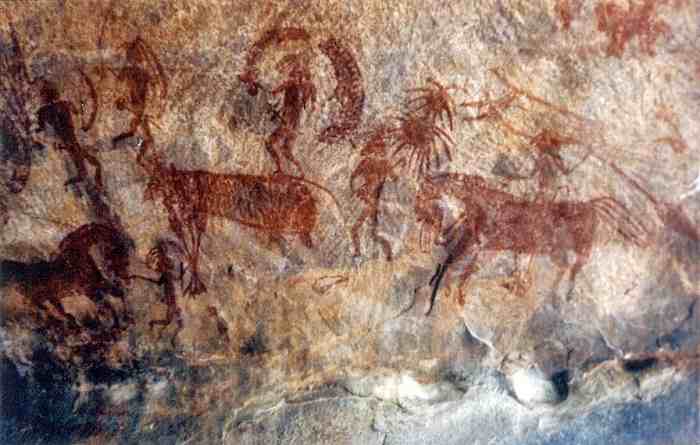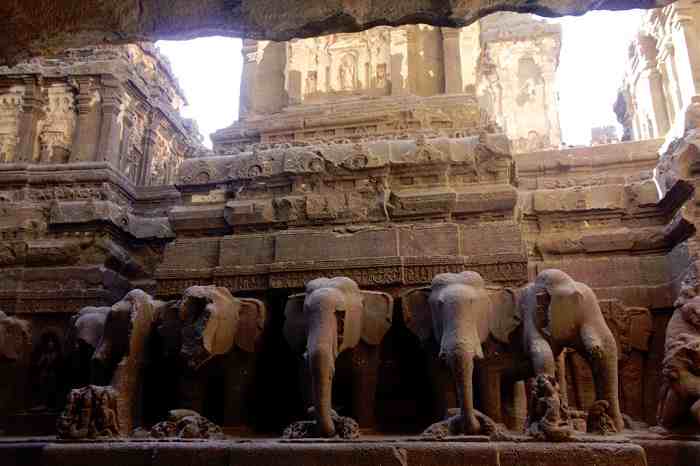
Image Credit: www.ghumakkar.com
The Rock-cut structures present the most spectacular piece of ancient Indian art specimen. Most of the rock-cut structures were closely associated with various religions and religious activities. In the beginning, remarkable Buddhist and Jain rock-cut structures were built in areas such as Bihar in the east and Maharashtra in the west. Numerous caves were excavated by the Buddhist monks for prayer and residence purposes. The best example of this is Chaityas (prayer halls) and viharas (monasteries). Inside these rock-cut structures, windows and balconies and gates were carved as huge arch shaped openings.
Rock-cut architecture occupies a very important place in the history of Indian Architecture. The rock-cut architecture differs from traditional buildings in many ways. The rock-cut art is more similar to sculpture than architecture as structures were produced by cutting out solid rocks. Let's have a look at various specimen of rock-cut architecture in ancient India. Some prominent rock-cut structures of ancient India are Chaityas, Viharas, temples etc.

Early Caves
Natural caves were the earliest caves used by local inhabitants. The natives used such caves for different purposes like places of worship and shelters. The Mesolithic period (6000 BC) saw the first use and modifications of the early caves, a fact manifested by archaeological evidences. The overhanging rocks embellished with petroglyphs or rock-cut designs that were created by carving, chiseling and abrading part of rock surfaces forms the early instances of such rock caves. The Bhimbetka rock shelters inside the tiger reserve called ‘Ratapani Wildlife Santuary’ located on the verge of the Deccan Plateau in Raisen District in the state of Madhya Pradesh, India, illustrates the settlement of human life in these rock shelters some hundreds of thousands years ago as also of the initiation of Stone Age in India. UNESCO declared this place as a World Heritage Site in 2003 which bears several Stone Age rock paintings, some of which are more than 30,000 years old. Early manifestations of dance art are also palpable from these caves.
The oldest surviving Indian rock-cut caves are the Barabar Caves that are situated in the Makhdumpur Block of Jehanabad district in the Indian state of Bihar. Some of these caves, most of which trace back to the 3rd century BC during the rule of the Maurya Empire (322–185 BCE), bear Ashokan inscriptions. These caves from the time of the great Indian emperor Ashoka and his grandson, Dasharatha speak volume of the policy of religious tolerance undertaken by the two emperors who were otherwise Buddhists. Different Jain sects thrived under their rule. Ascetics from Ajivika sect, a ?rama?a movement that remained a major contemporary of early Buddhism and Jainism, which was founded in the 5th century BCE by Makkhali Gosala, used these caves. Many rock-cut Hindu and Buddhist sculptures are found in these caves.

Cave Temples
The Western Deccan region consists of many early cave temples that date back to a period between 100 BC and 170 AD. Most of these cave temples stood as Buddhist monasteries and shrines. Presumably these caves had wooden structures that decayed with time. The Bhaja Caves tracing back to the 2nd century BC that include a total of 22 rock-cut caves situated in city of Pune, Maharashtra; the Bedse or Bedsa Caves dating back to around 1st century BC, located in Maval taluka, Pune, Maharashtra; the Karla or Karle Caves or Karla Cells that developed as ancient Indian Buddhist rock-cut cave shrines between 2nd century BC to 5th century AD, situated in Karli, Maharashtra; the Kanheri Caves comprising of a group of rock-cut monuments dating back between 1st century BCE to 10th century CE, situated within the forests of the ‘Sanjay Gandhi National Park’ in the western outskirts of Mumbai, Maharashtra; and some of the famous Ajanta Caves comprising of 30 rock-cut Buddhist cave monuments dating from the 2nd century BCE to around 480 or 650 CE, located in the Aurangabad district of Maharashtra are counted as the earliest surviving cave temples in India.
The Buddhist missionaries employed the caves as shrines and shelters conforming to the religious concepts of asceticism leading a monastic life. The ancient Buddhist and Jain cave basadis, monasteries and temples are instances of early rock-cut architecture. The caves at Kanheri and Ajanta saw eventual occupation by the Buddhist monks. Indications of association between the religion and commerce are palpable from the relics of the caves. Sources mention that traders many a times travelled the active international trade routes through India in company of the Buddhist missionaries. For instance the Bhaja Caves situated 400 feet above the Bhaja village lies on a significant age-old trade route that ran from the Arabian Sea eastward to the Deccan plateau. Buddhism ideology advocated trade practices and these Buddhist monasteries often provided lodging facilities for traders who stopped over in these Buddhist abodes while on trade routes.
According to sources the natives of Indus Valley commenced on maritime trading contact with Mesopotamia during the 3rd millennium BCE and as such trade prospered between South-East Asia and the Roman Empire, some of the cave temples witnessed inclusion of elaborate facades, arches and pillars courtesy patronage of wealthy traders. Royal and mercantile endowments soon started pouring in which saw elaboration of cave interiors including embellishment of interior walls of the caves with exquisite carvings, reliefs and paintings. The exteriors of the caves were face-lifted with facades and the interiors were apportioned for different purposes like developing areas for cave shrines called chaityas which are the congregational worship halls and viharas or monasteries where the monks resided. As centuries passed the skilled artisans turned the more simple caves into elaborate structures that looked more like free-standing buildings. The wood-like themes embellished on these ancient rock-cut caves showcase the craftsmanship of artists of those times who skilfully etched timber texture, structure and grain in these caves. The pillared inner circle chamber of earliest rock-cut garbhagriha, that is the sanctum sanctorum, allowed devotees to circumambulate around the stupa.
Many cave temples were later developed under the patronisation of southern Indian Hindu kings and were dedicated to Hindu gods and goddesses. The earliest known examples of Hindu temples are the Badami Cave temples that comprise of four Hindu cave temples apart from a Jain and presumably a Buddhist cave temple situated in the town of Badami in northern Karnataka. These cave temples date back to the 6th century and are regarded as fine examples of Badami-Chalukya architecture that adorn decorative pillars, intricately carved sculptures, embellished brackets and finely chiseled ceiling panels. Striking sculptures adorning these cave temples including that of Tandava-dancing Shiva as Nataraja in Cave 1 and relief of Vishnu as Trivikrama in Cave 2 among others illustrate Hindu themes and divinities.
Although several ancient stupas, monasteries and temples were destroyed due to several reasons including degradation and vandalism, the cave temples stood the test of time and survived presumably due to less visibility as also because of the fact that these were constructed out of more durable material compared to masonry and wood. Most of the cave temples that exist today, which counts to around 1200, are Buddhist temples.

Monolithic Rock-Cut Temples
The architects of the Pallava Dynasty initiated rock carving to create monolithic structures that resemble temples. A monolithic rock-cut temple is chiselled out of a single colossal rock in the shape of masonry or wooden temples including embellishment on walls and other areas showcasing fine work of art and engineering. The Pancha Rathas or Pandava Rathas of Mahabalipuram situated on the Coromandel Coast of the Bay of Bengal are the most excellent architectural edifices typifying monolith Indian rock cut architecture. The five structures shaped as rathas or chariots chiselled out of large block of stone of granite dates back to the 7th century and are named after the five Pandava brothers and their common spouse Draupadi from the great Indian epic ‘Mahabharata’. Marked as ‘Group of Monuments at Mahabalipuram’ by ‘UNESCO’ and enlisted in its World Heritage Sites list, the site showcases varied Dravidian architecture. It has reflections of the Buddhist Viharas and Chaityas and became templates to temples of much higher dimensions built later in Tamil Nadu.
The Kailash temple considered as one of the most colossal age-old rock-cut Hindu temples forms cave temple number 16 of Ellora, which is counted among the largest rock-cut monastery-temple caves complexes of the world and marked as a UNESCO World Heritage Site in Maharashtra, India. Among the 100 caves of Ellora, 34 caves are open to public of which the Kailash temple shaped as a chariot is regarded as one of the most magnificent cave temples in India. Construction of this megalith is attributed to the 8th century king Krishna I of the Rashtrakuta dynasty in 756-773 CE. Dedicated to Lord Shiva, the temple showcases fine architectural works including relief panels depicting the two main Hindu Epics namely the Ramayana and the Mahabharata. Pallava and Chalukya styles of architecture are noticed in this cave temple which is decorated with carved sculptures including that of gods and goddesses from the Hindu Puranas, mystical beings such as divine musicians and nymphs and figures depicting fertility and good fortune.



